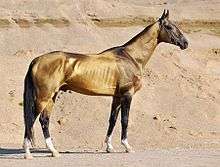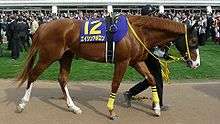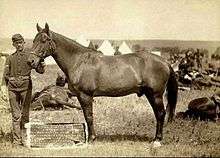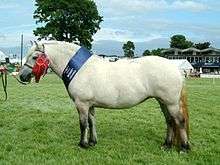Henneke horse body condition scoring system
The Henneke horse body condition scoring system is a numerical scale used to evaluate the amount of fat on a horse's body. It was developed by Henneke et al. (1983) at Texas A&M University with the goal of creating a universal scale to assess horses' bodyweight.[1] It is a standardized system that can be used across all breeds without specialized equipment; condition is assessed visually and by palpation.[2] Scores range from 1 to 9 with one being poor and nine being extremely fat; the ideal range for most horses is from 4 to 6.[2] The table below gives a description of the possible body condition scores. The system is based on both visual appraisal and palpable fat cover of the six major points of the horse. The system is used by law enforcement agencies as an objective method of scoring a horse's body condition in horse cruelty cases.[3]
Scoring system
| Score | Description | Image |
|---|---|---|
| 1. Poor | Extremely emaciated; no fatty tissue; vertebrae, ribs, tail head, and bones of withers, shoulder, and neck are visible | .jpg) This horse was assessed with a Henneke body condition score of 1 |
| 2. Very Thin | Emaciated; slight tissue cover over bones; vertebrae, ribs, tail head, and bones of withers, shoulder, and neck are visible | .jpg) This horse is very thin, assessed at a 2 |
| 3. Thin | Slight fat cover over body; individual vertebrae and ribs no longer visibly discernible; withers, shoulders, and neck do not appear overly thin | Detail of a relatively healthy older horse coming out of winter a bit too thin |
| 4. Moderately Thin | Ridge of spine and outline of ribs are visible; tail head may or may not be visible depending on the breed; withers, shoulders, and neck do not appear overly thin |  Lean horse in fit condition |
| 5. Moderate | Spine and ribs cannot be seen however ribs can be felt; tail head is spongy; withers, shoulders, and neck are rounded and smooth |  A conditioned racehorse in good flesh |
| 6. Moderately Fleshy | Slight crease down spine; ribs and tail head feel spongy; fat deposits along withers and neck and behind shoulders |  A horse in good condition, about a 6 on the scale |
| 7. Fleshy | Crease down spine; ribs have fat filling between them; tail head spongy; fat deposits along withers and neck and behind shoulders |  A show pony with visible fat deposits |
| 8. Fat | Apparent crease down spine; ribs difficult to feel; soft fat surrounding tail head; fat deposits along withers, behind shoulders, and on inner thighs; neck is large | .jpg) This horse was assessed at an 8 on the Henneke scale |
| 9. Extremely Fat | Obvious crease down spine; patchy fat on ribs; bulging fat on tail head, withers, behind shoulders, and on neck; fat fills in flank and on inner thighs | _2011-03-20_17-30-00.jpg) This horse is noticeably overweight, fat fills in flank, cresty neck |
Ideal scores

The average horse is healthiest with a body condition score between 4 and 6, which indicate that the horse has a proper balance of feed to exercise.[5] An Easy keeper or hard keeper should be watched closely as they are prone to either being overweight or underweight, respectively.
- Breeding Mares
Breeding mares with a body condition score less than five have been linked in research to problems with reproduction. The energy demands of milk production for a foal are very high, so most mares will lose condition while lactating.[2] Also, a mare with a body condition score less than five will have more difficulty conceiving.[2] For these reasons, recommendations are for breeding mares to score between 6 and 7. Higher body condition scores have not been shown to affect reproduction but are unhealthy for the horse.[2]
- Stallions
Stallions have the best reproductive success at a body condition score of 5 or 6.[6] Stallions have a high energy output during breeding season so some advise a stallion begin the breeding season at a 6 or 7[2] to keep him within the healthy range at the end of the breeding season. If a stallion has a body condition score less than 3 or greater than 8, reproductive performance is compromised.[6]
- Performance Horses
There has not been much research on the connection between body condition score and performance ability in horses so optimum scores are unknown.[2] However, horses with a low body condition score lack the fat reserves for strenuous work and also may lack lean muscle.[7] Horses with high body condition score carry too much weight, which interferes with stamina and biomechanics.
- Horses on Winter Pasture
Horses on pasture should enter the winter season at a body condition score of 6 or 7. On extremely cold days, a horse cannot eat enough food to balance the energy requirements of maintaining body heat so condition is often lost over winter.
Management
Monitoring a horse's body condition may alert a horse owner or barn manager to potential health or management issues. Body condition score can be affected by a variety of factors such as feed intake, weather, exercise, metabolic diseases like Equine metabolic syndrome, illness, tooth issues, parasitic infections, reproduction, and many others. Appropriate horse care allows a proper body condition to be maintained in the horse.
See also
References
- ↑ Henneke; Potter GD; Kreider JL; Yeates BF (October 1983). "Relationship between condition score, physical measurements and body fat percentage in mares". Equine Vet: 371–2.
- 1 2 3 4 5 6 7 Body Condition Scoring your Horse Retrieved 2012-03-21
- ↑ Habitat for horses, Henneke Body Condition Scoring table including photos Retrieved 2009-11-3
- ↑ Novak, Susan; Anna Kate Shoveller (2008). "Evaluating your Horse's Condition". In Ken Blackley. Nutrition and Feeding Management for Horse Owners. Alberta Agriculture and Rural Development. pp. 1–3. ISBN 0-7732-6078-1.
- ↑ Introduction to Body Condition Scoring Horses Retrieved 2012-03-21
- 1 2 Novak, Susan; Anna Kate Shoveller (2008). "Feeding Management". In Ken Blackley. Nutrition and Feeding Management for Horse Owners. Alberta Agriculture and Rural Development. pp. 71–91. ISBN 0-7732-6078-1.
- ↑ Garlinghouse, S.E.; Burrill, M.J. (July 1999). "Relationship of body condition score to completion rate during 160 km endurance races". Equine Veterinary: 591–595.
External links
- University of Maine - Body Condition Scoring for your Horse −
- Article on body scoring at The Horse
- Horse care standards, UC Davis, see pages 18–20
- University of Tennessee, see pages 6–10